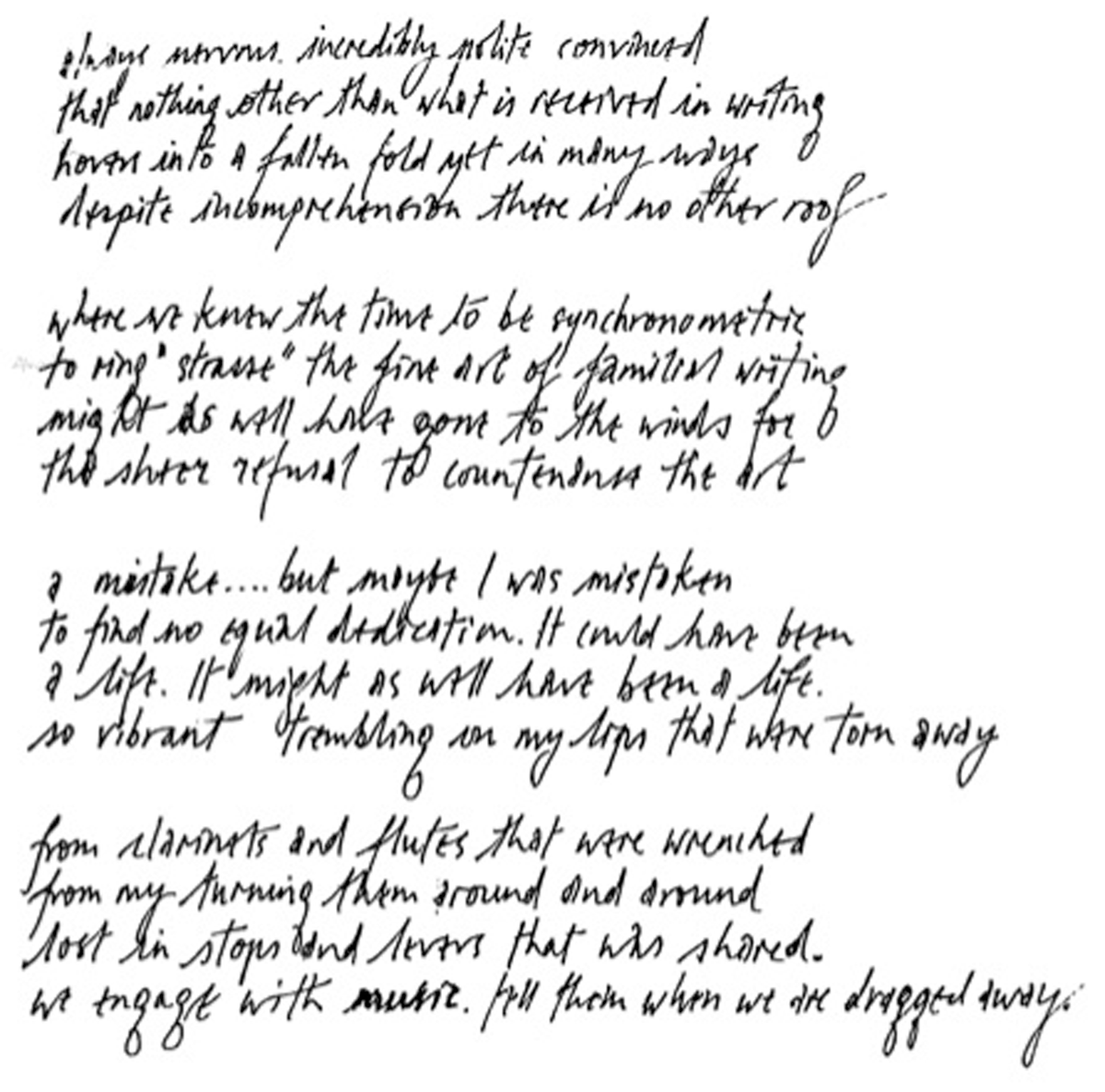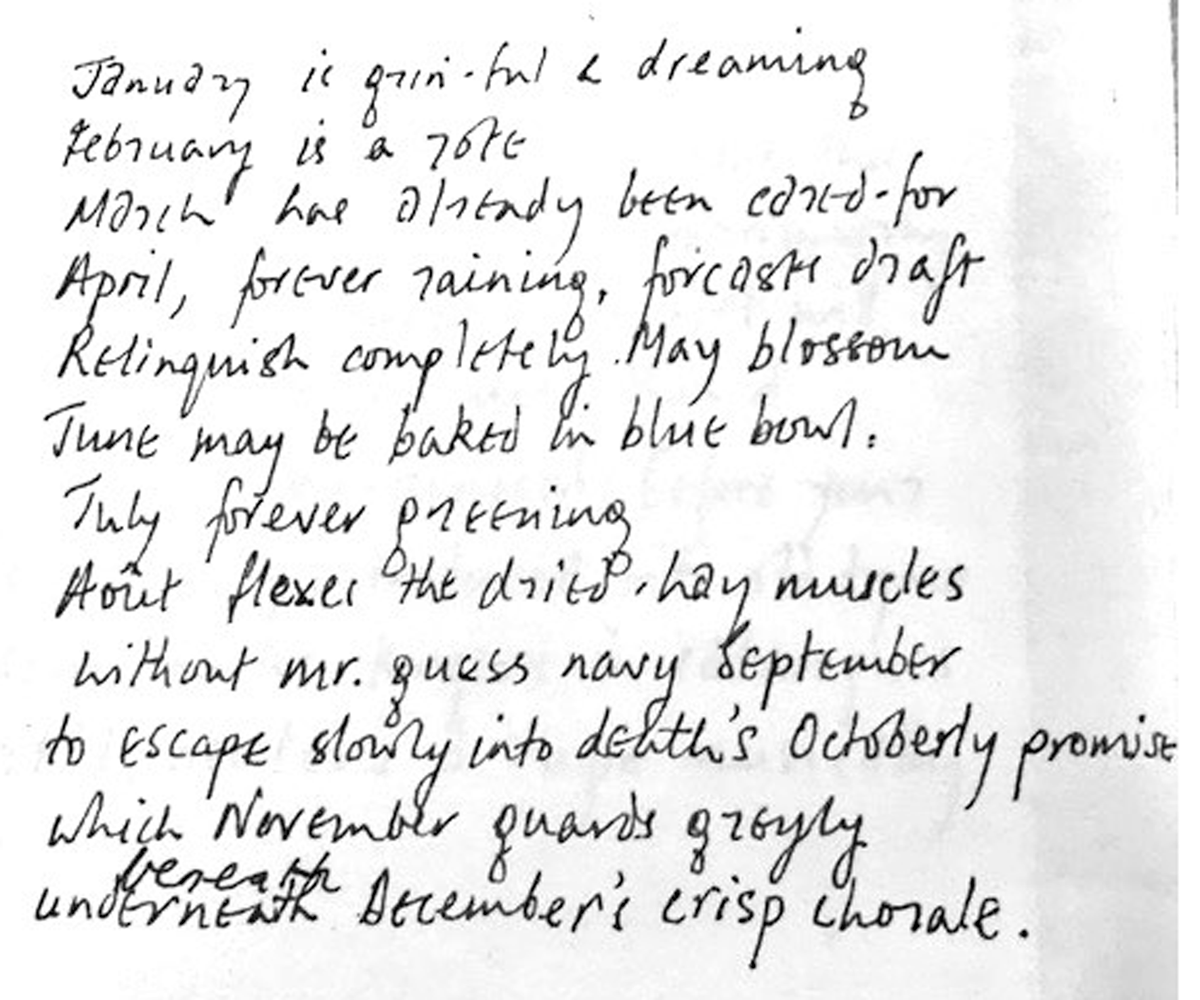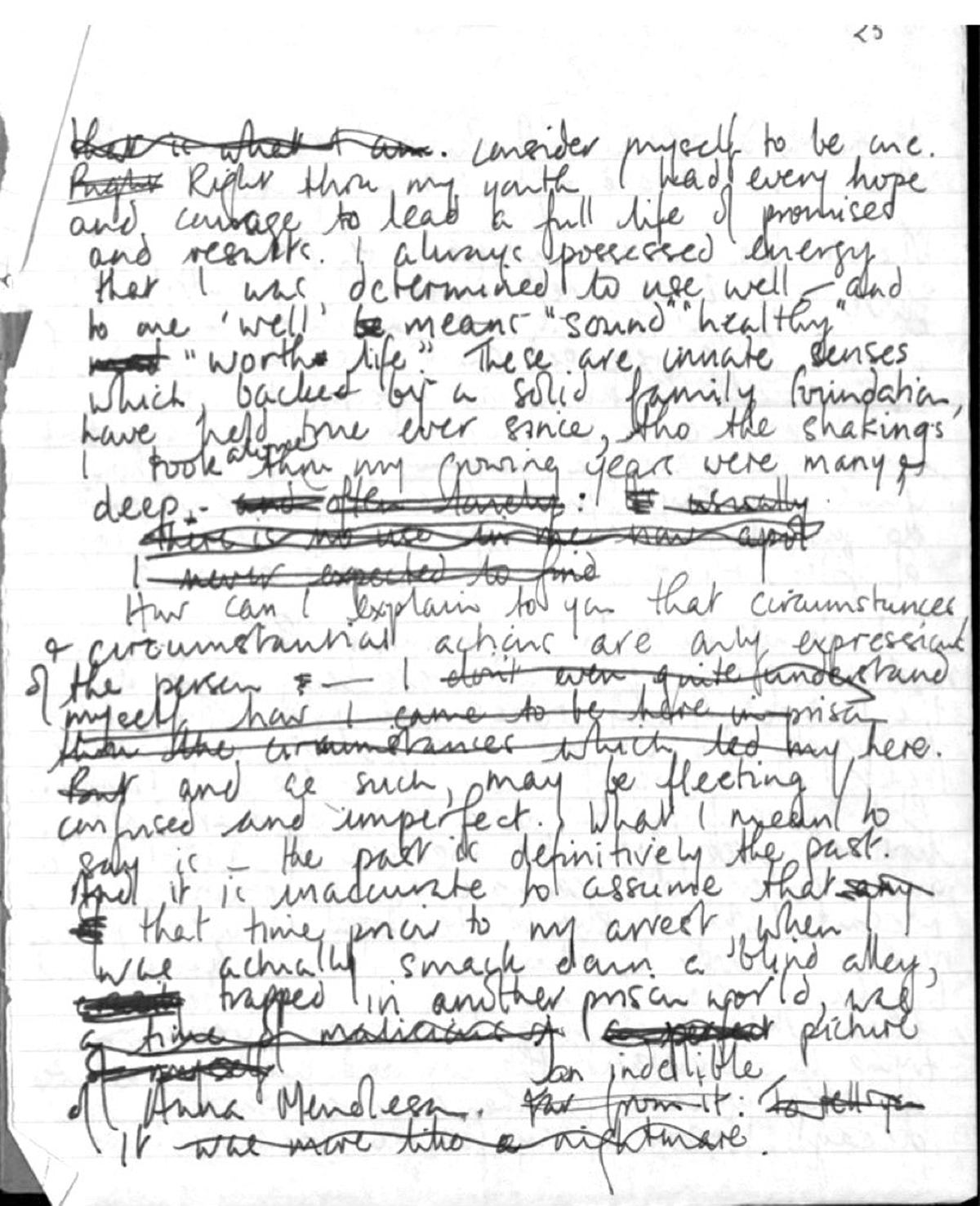Some of the most quietly powerful moments in Implacable Art (2000) emerge in the three untitled, handwritten, and drawn poems that punctuate the blocks of printed text in the collection. The handwritten imitation of typeface registers a proclivity for the more primitive handicraft mode of production that characterised much of late-modern poetry and—in particular—the poetry produced by Mendelssohn’s peers.1 Glimpses of Mendelssohn’s unease with the more mechanised modes of textual reproduction emerge throughout her archive, both in her unpublished writing and correspondence. For instance, a letter to her close friend David Kelley reads: ‘I do think that the reductionism of productivity to instantaneity erodes some first rate publishing structures’.2 In an untitled fragment beginning ‘death, the evaporating emotion’, Mendelssohn similarly writes: ‘isn’t printing hard work? They [Leigh Hunt and his brother] didn’t do it by computer. Geoffrey Hill’s theories on Blake’s manual labour as an engraver are interesting on this’.3
Blake was pervasive in the aspiring counter-culture of the late sixties and early seventies to which Mendelssohn was tangentially associated: a period that also saw the establishment of a remarkable number of small presses, developments in offset-litho printing and do-it-yourself typesetting. Yet the fascination with scribal penmanship could also be a nod to the Russian avant-garde practice of highlighting the visual forms of language on the page with handwriting, typography, and a mix of pictorial and linguistic elements. Through the revolutionary practice of faktura, a practice that grew out of visionary and socialistic intent, writers like Velimir Khlebnikov and Aleksei Kruchenykh incorporated ‘the technical means of construction into the work itself’.4 This faith resurfaces in the handwritten poems of Implacable Art, in which the writing subject locates herself in every curve and line. In her memoir of Mendelssohn, Lynne Harries comments on the poet’s distinctive cursive style: ‘people admired her handwriting. It was so small, regular, and consistently formed, always sloping forward at the same angle’.5
Inconsistencies abound too, of course. While some of Mendelssohn’s writing add to the general impression of writing-as-artefact by deploying rounded lettering and moderate but antiquated flourishes (Figure 2), others become almost illegible to the reader. This is evinced, in particular, in her unpublished prison exercise books, where the general uprightness of her handwriting with its varying stroke thickness create a more cluttered effect and speak of the constrained space in which they were produced (Figure 3).
Mendelssohn’s tense, frenetic style of writing in this exercise book is a sharp departure from the spaced writing and visual scansion of ‘Baked’s are in for tender hearts’. Two distinct styles of writing might thus be gleaned from the two images: one in which authorial creativity is emphasised through a flowing, early-modern hand and generous allocation of space, and the other which bespeaks of an abjected, ‘punishing productivity’.6 The harrowing experience of prison cramps Mendelssohn’s writing hand, yet she cannot stop writing: justifying and retracting her words before diving into ‘a bottomless ne plus ultra of suspicion’.7
The handwritten poem in Implacable Art, beginning with the phrase ‘always nervous’, is rooted in such capacious incompatibilities (Figure 1). The calligraphy used for the text of the poem creates a style that teeters between modern and late-medieval. The compactness of the lettering engenders a more modern effect, whereas the angular lower loops of the ‘g’s that are closed with a fine hairline invoke a late-medieval hand. The ‘d’ with its backswept ascender is very similar to the expansive and near-Gothic round letters used in the manuscript draft of ‘Baked’s are in for tender hearts’: a poem that appears in the 1983 collection titled ‘I’m working here’. This ‘d’ was, in fact, common in the Secretary style that preceded italics in England and is derived from Latin Uncials — a mode of lettering that is excluded from cursive forms because of the obvious difficulty in accurately reproducing it.8 The blended calligraphy is strikingly apposite to Mendelssohn’s equally pervasive tendency towards complexity and contradiction. As Harries reminds us, Mendelssohn ‘dealt in the complex and partly glimpsed, in her poetry and her life’.9 Indeed, difficulty—one that is reproduced variously in her writing as opacity; artifice; secrecy; prolixity; incomprehensibility; or even indecipherability—is one of Mendelssohn’s most pronounced aesthetic drives. As we shall soon see, it remains deeply embedded in ‘always nervous’ as well, creating—at times—a crisis of confidence for the reader who is eager for completion and closure.
The poem, as I see it, opens with the following declaration: ‘always nervous incredibly polite convinced’ (11). The phrase ‘always nervous’ suggests the sharing of interiority: a desire that is voiced and retracted over the next few lines. This half-life of desire is circumscribed by the next phrase (‘incredibly polite’) that maps a shift back to the energy of public self-protectiveness. The line creates a speaking voice that is neither impersonal and objective nor consistently intimate: one that reserves the option to alter at will. Both phrases in the opening line appear decapitated at both ends by its vacant subject and object positions. The performance of subjectivity thus derives from a core that is uncertain and unpresentable, and is precariously stabilised throughout the poem. The indefiniteness of reference engenders much of the difficulty in this poem: a mode of difficulty that is not syntactical or lexical but inheres in the persistent absence of context and the way in which personal confessions are begun and quickly abandoned.
The poem further thematises its own procedures and difficulty through the figure of the fold, which appears in the next few lines: ‘that nothing other than what is received in writing | hovers into a fallen fold yet in many ways’. The figure of the fold might invoke a deepening of conceptual space: a counter, perhaps, to the flat surfaces that are typical of postmodern topographies. It may well encapsulate those moments when an unfathomable space opens up in Mendelssohn’s writing that the narrative cannot easily cross: hidden involutions of narrative that bespeak of another world, no matter how distant or impossible it seems. Yet, crucially—à la Gilles Deleuze’s reading of the fold—it might also draw attention to the temporary and convoluted boundary that exists between the body and the world. In an article that mobilises the Deleuzian metaphor of the fold for feminism, Mieke Bal writes: ‘(T)hrough the fold, subjectivity and the object become codependent, folded into one another, and this puts the subject at risk’.10 For Mendelssohn, this risking of the subject obligates the return to difficulty: ‘despite incomprehension there’s no other roof’. This is necessary incomprehensibility: one that compromises as well as inoculates.
The association of poetic difficulty with protectiveness recurs in Mendelssohn’s correspondence, particularly in her letters to the poet and publisher Rod Mengham that were exchanged around the time of Implacable Art’s publication. In one such letter, Mendelssohn writes: ‘I am being used & my published writing is being subjected to analyses that cannot possibly be relevant to the writing itself’.11 Later letters express a similar disdain: ‘I suppose that my life was endangered. Reading poetry without a protective screen’.12 Mendelssohn’s poetry is both bristled by this injury and acts as its own salvation. Her faith that form-defiant language might act as a ‘protective screen’ appears tied to lifelong proclivities towards incomprehensibility and difficulty. It is in this vein that we might also read the proximity enacted between the word ‘“strasse”’ in the second stanza of ‘always nervous’ and ‘the fine art of familial writing’. Unlike the coinage ‘synchronometric’ from the first line of the same stanza, ‘strasse’ is not a neologism or a nonce word devoid of history or emotional colour. Ambiguous and multivalent, it may refer to Strasserism, a strand of Nazism which re-emerged in the United Kingdom in the early 1970s; or to the Rosenstraße demonstrations of 1943 where non-Jewish German women marched against the incarceration of around 2000 Jews in Nazi Germany (Mendelssohn was acutely aware of her Jewish heritage and highly alert to the legacy of fascism in Europe); or simply to a street.13 In her edited collection of Mendelssohn’s poetry, Sara Crangle thus writes: ‘(I)n league with the modernist tradition, difficulty—quite often deployed to evade the censor—wins out’.14 It fulfils the imperilled poet’s need for circumspection, and takes its ethical valence from the specific contexts in which it appears rather than from any inherent ethical import.
Yet the poem is not without its transcendent moment of hope. The first person plural ‘we’ (‘we engage with music’) that appears in the final line enacts a telescoping of the individual into the collective. Despite the instances of violence that pepper the text and the extensive references to taking away with force (life that was ‘torn away’; ‘clarinets and flutes that were wrenched’)—there exists a fragile community of pronouns that runs poignantly throughout the poem. It is held in perilous suspension in the last line, in particular, which reads: ‘we engage with music. tell them that when we are dragged away’ (emphasis in original). The line returns us to Mendelssohn’s refrain of being dragged away (an assertion commonplace in her poetry and correspondence) yet it also alerts the reader to an erotics of hold and release; of desire and death. That desire might be read as the desire to call upon a ‘we’—a precarious community forged even at the face of unremitting violence—and exhort them to speak while bodies are hollowed of language and landscapes are evacuated of bodies. For a collection that alludes so extensively to collateral violence and the political failures of community, this is a powerful moment: one that bespeaks of an intimacy addressed from alienation, which pulsates just beneath the surface of Implacable Art and erupts occasionally with giddying force.
Notes
- Nigel Wheale, ‘Infernal methods – A Memorable Fancy’ (unpublished). I am extremely grateful to Nigel Wheale for generously providing me with a copy of this essay. [^]
- See SxMs109/3/A/1/25. Kelley (1941–1999) was a poet and fellow of Trinity College, Cambridge. He assisted her in her arrangements to study G. Prassinos’ works in Paris. All references beginning ‘SxMs’ refer to the Anna Mendelssohn Archive (1928–2013), University of Sussex Special Collections, The Keep, Brighton, UK. [^]
- SxMs109/1/B/1/4. [^]
- In ‘Infernal methods – A Memorable Fancy’, Wheale writes about the Russian vanguardist, or constructivist, concern with faktura: ‘(T)he word was redefined and fought over for at least a decade, but at one point, for the constructivists, faktura came to mean incorporating the technical means of construction into the work itself and linking them with existing standards for the development of the means of production in society at large’ (7). See also, Benjamin H. D. Buchloh, ‘From Faktura to Factography’, October 30 (Autumn 1984), 82–119: 89. http://realismworkinggroup.files.wordpress.com/2008/10/buchloh_factography.pdf. [^]
- SxMs109/1/A/1. [^]
- Eleanor Careless, ‘Art Takes All My Time: Work in the Poetry and Prison Writing of Anna Mendelssohn’, in Poetry and Work: Work in Modern and Contemporary Anglophone Poetry, ed. by Joseph Walton and Ed Luker (Palgrave Macmillan: London, 2019), p. 166. [^]
- Sara Crangle, ‘The Agonies of Ambivalence: Anna Mendelssohn, la poétesse maudite’, in Modernism/modernity 25.3 (2018), p. 461. [^]
- Nicolete Gray, A History of Lettering: Creative Experiment and Letter Identity (Boston: Godine, 1986). [^]
- Harries, p.5. [^]
- Mieke Bal, ‘Enfolding Feminism’, in Feminist Consequences: Theory for the New Century, ed. by Elisabeth Bronfen and Misha Kavka (New York Chichester, West Sussex: Columbia University Press, 2001), p.333. [^]
- SxMs109/3/A/1/34/2. [^]
- ibid. [^]
- N. Copsey, Contemporary British Fascism: The British National Party and the Quest for Legitimacy (2004), pp. 17–18. See also, United States Holocaust Memorial Musuem. “The Rosentrasse Demonstration, 1943.” Holocaust Encyclopedia. https://encyclopedia.ushmm.org/content/en/article/the-rosenstrasse-demonstration-1943. Accessed on August 31, 2021. [^]
- Anna Mendelssohn, I’m Working Here: The Collected Poems of Anna Mendelssohn, ed. Sara Crangle (Swindon: Shearsman Books, 2020), p. 42. [^]
Acknowledgements
Images reprinted with kind permission of the Mendelssohn estate.
Competing Interests
The author has no competing interests to declare.


